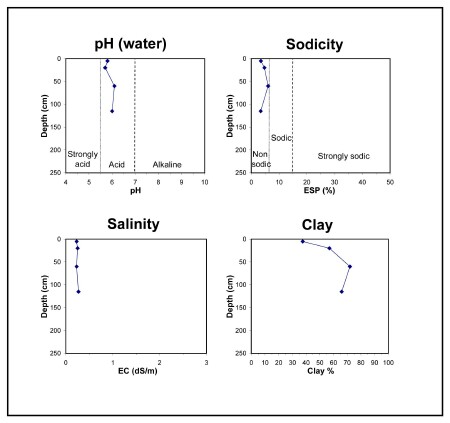GL73
| Site: GL73 | Land Unit: Branxholme Basalt |
| Aust. Soil Class.: Mottled, Eutrophic, Red CHROMOSOL (high free iron) (confidence level 1) | |
| General Land Unit Description: This site is an example of the isolated pockets of red soils high in free iron, which occur on some of the basalt land units. This soil type has potential for more varied land use due to favourable physical and chemical properties. Due to restrictions of scale, it is difficult to separate the pockets of red soils as they typically occur in conjunction with Ferric Brown Chromosols, which are perceived as being dominant. The Ferric Chromosols have more restrictions for land use, due in part to a ferric horizon above the clay, and a subsoil that has impeded drainage. |
Site Description:
| Slope: 2% | Geology: Quaternary basalt |
| Landform pattern: Gently undulating plain | Position in landscape: Upper slope |
| Internal drainage: Imperfectly drained |
Soil Profile Morphology
| A1 | 0-10 cm | Dark reddish brown (5YR3/2) clay loam, moderate to strong subangular blocky structure (2-5 mm), firm consistence when dry, a few small subrounded ferruginious and manganiferous nodules (2-6 mm), pH 5.8; transition to: |
| Subsoil | ||
| B21 | 10-20 cm | Dusky red (2.5YR3/4) light medium clay, moderate to strong subangular blocky structure (2-5 mm), very firm to strong consistence when dry, a few medium subrounded or subangular blocky ferruginious and manganiferous nodules (2-10 mm), pH 5.7; transition to:
|
| B22 | 20-50 cm | Reddish brown (2.5YR4/4) medium clay, many distinct red mottles, moderate subangular blocky structure (5-10 mm), very firm to strong consistence when dry, very few coarse fragments pH 6.1; transition to: |
| B3 | 50-90 cm | Reddish brown (2.5YR4/4) heavy clay, many prominent red mottles, strong consistence when dry, pH 6.0. |
Key profile features:
- Mottled subsoil
- High in free iron




